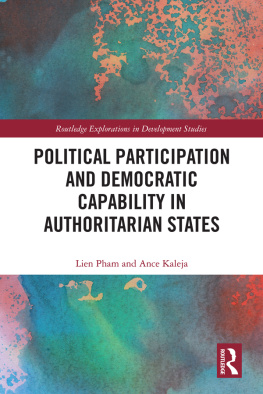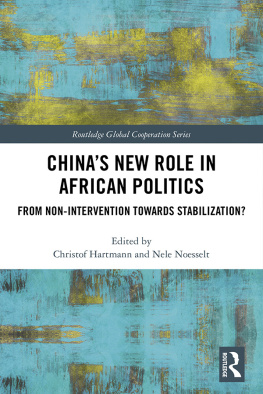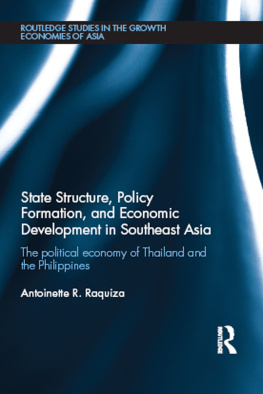THE ROOTS OF POLITICAL INSTABILITY IN NIGERIA
To my parents Raymond Chilaka, and Rose Ojiakuede Ejiogu, and Ngozi, Nwamaka, Amanze, and Chimeerem
The Roots of Political Instability in Nigeria
Political Evolution and Development in the Niger Basin
E.C. EJIOGU
University of Maryland, College Park, USA
First published 2011 by Ashgate Publishing
Published 2016 by Routledge
2 Park Square, Milton Park, Abingdon, Oxon OX14 4RN
711 Third Avenue, New York, NY 10017, USA
Routledge is an imprint of the Taylor & Francis Group, an informa business
Copyright 2011 E.C. Ejiogu
E.C. Ejiogu has asserted his right under the Copyright, Designs and Patents Act, 1988, to be identified as the author of this work.
All rights reserved. No part of this book may be reprinted or reproduced or utilised in any form or by any electronic, mechanical, or other means, now known or hereafter invented, including photocopying and recording, or in any information storage or retrieval system, without permission in writing from the publishers.
Notice:
Product or corporate names may be trademarks or registered trademarks, and are used only for identification and explanation without intent to infringe.
British Library Cataloguing in Publication Data
Ejiogu, E. C.
The roots of political instability in Nigeria : political evolution and development in the Niger Basin.
1. Political stability--Nigeria. 2. Nigeria--Politics and government--To 1960. 3. Nigeria--Politics and government--1960- 4. Nigeria--Social conditions. 5. Cultural pluralism--Political aspects--Nigeria.
I. Title
320.9'669-dc22
Library of Congress Cataloging-in-Publication Data
Ejiogu, E. C.
The roots of political instability in Nigeria : political evolution and development in the Niger Basin / by E.C. Ejiogu.
p. cm.
Includes bibliographical references and index.
ISBN 978-0-7546-7987-5 (hardback) 1. Political stability--Nigeria--History. 2. Nigeria--Politics and government. I. Title.
JQ3096.E37 2011
320.9669--dc22
2010034090
ISBN 9780754679875 (hbk)
ISBN 9781315553214 (ebk)
Contents
List of Maps and Figures
List of Maps
List of Figures
List of Tables
Maps
Map 1 Showing the Role of Geography in the Racial Make-up of the Inhabitants of the Niger Basin
Source: Buchanan, Pugh and Brown (1955: 80).
Map 2 Showing the Igbo and other Inhabitants of Southeast Lower Niger Basin
Source: Coleman (1958: 29).
Map 3 Showing the Yoruba and the Other Inhabitants of Southwest Lower Niger Basin
Source: Coleman (1958: 26).
Map 4 Showing the Upper Niger Basin and Some of its Inhabitants
Source: Coleman (1958: 19).
Map 5 Showing the Trans-regionalism that Resulted from European Intervention in the Niger Basin
Source: Coleman (1958: 17).
Preface
The constant drum beat of headlines about Dafur, Zimbabwe, Sudan, Somalia, as well as the other states in Africa that are beleaguered by political instability had made the causes of failed states and intra-state political conflicts a major issue, both academic and practical. Latter day scholars, including Larry Diamond (2008), Larry Diamond and Marc F. Plattner (1999, 2001), Ian OFlynn and David Ressell (2005), Donald L. Horowitz (2006), Julius O. Ihonvbere and John M. Mbaku (2003) and a host of others have brought up issues of democratic rule and the need for consolidating what may have been accomplished in that regard in Africa since the new wave of political transition in the 1990s. However, the slant of the discourse has not shifted that much to include definitive prescriptions on how to utilize the diversity of Africas age-old cultural patterns as the foundation of durable state building. Culture matters and cultural factors play crucial roles in social, economic, and political development of societies (Huntington 2000). At a time when cultural obstacles to Africas development (Harrison 2000: xxiii) have been raised (Etounga-Manguelle 2000) severally in social science discourse, its imperative also to bring forth specific aspects of Africas cultural patterns that remain relevant and worthy of adoption in the search for stable political development on the continent. If the diversity of cultures and patterns that abound in Africa cant be wished away as obstacles to state building as used to be the case (Young 2002), they should be better understood and harnessed in the search for viable forms of political arrangement. Its not sufficient to simply submerge the issues that tug at the heart of political conflicts in Africa in the context of ethnic groups in conflict as Donald L. Horowitz (1985) has done. Instead, Africas ethnic diversity, which ordinarily is often framed as a large and negative anachronism could perhaps be utilized in our quest to understand how we could build viable states on the differences in authority patterns in Africas distinct nationality groups.
This piece of work addresses the following four crucial elements that have been ignored in the discourse on the causes of political instability in contemporary African states:
1. It advocates and takes an evolutionary perspective across a century of time to account for political developments in and amongst the distinct nationalities that constitute Nigeria, which is also one of Africas largest and most critical contemporary states.
2. It recommends and adopts the Eckstein-Gurr congruence-consonance theoretical framework to examine the internal variations evident in the Nigerian state and to account for why it experiences political conflict.
3. It utilizes the same framework to describe the differences in authority patterns of some of the nationality groups that constitute the Nigerian supranational state as another cause of the instability that it experiences and why it might even fail if the authority patterns of those diverse groups are not properly harnessed and channeled into meaningful state building. The concept of supra-national state is coined and used in the book to describe a polity that emerged from an arbitrary colonial process to comprise hitherto distinct and autonomous nationality groups that still lay claims to their distinctiveness. Most if not all of Africas contemporary states can rightly be called supra-national entities.














